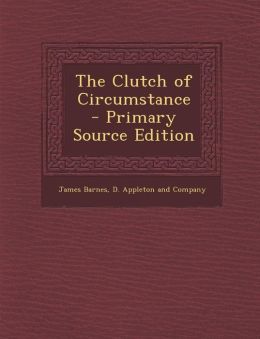"Circumstantial fiddlesticks!" snapped the Thinking Machine. "I wouldn't convict a dog of stealing jam on circumstantial evidence alone, even if he had jam all over his nose." — Jacques Futrelle, "The Problem of the Motor Boat"Although primarily known for roughing it in the wilds of Africa or upon the vasty deep and then writing books about it, James Barnes did find the time to produce a couple of crime fiction titles:
OUTSIDE THE LAW.
By James Barnes (1866-1936).
D. Appleton.
1905. 281 pages. $1.50
Online HERE and HERE.
[Full article] In this book James Barnes has written a detective story with the detective left out.
A gentleman of wealth has undertaken as a hobby, entirely for his own delectation, the engraving of imitations of old and valuable prints. He finds that his assistant has used the secret process, which he has taught him to make counterfeit plates of bank notes. The plates fall into his hands, and are promptly stolen.
Complications result which are intricate and mysterious enough to keep the reader in suspense to the end. — "Comment on Current Books," THE OUTLOOK (January 6, 1906)THE CLUTCH OF CIRCUMSTANCE.
By James Barnes (1866-1936).
D. Appleton and Company.
1908. 385 pages.
Online HERE, HERE, and HERE.
[Full review] In "Wonderland" this would be called a portmanteau story. Not content with the motive of lovers parted by slander and fraud, incriminating photographs and damning silences, the author gives us the drug-taking motive, the flippant other woman, the labor strike, the dynamited dam, then the murder and mystery motive, the familiar trial scene, the death-bed confession; and finally lets us gayly cheer the bride.
It is unquestionably commodious and fairly interesting. But the portmanteau story to be perfect must be packed solidly or on the journey the contents fall to hitching and fidgetting.
The persistent use of "will" for "shall" is not original with Mr. Barnes. Unfortunately he has abundant precedent. But let him look to his guides. Simplified grammar is, we trust, still in abeyance. — "Current Fiction," THE NATION (June 18, 1908; go to page 558, top middle)
. . . Another volume of lurid melodrama comes from the pen of Mr. James Barnes. Its material includes a mistaken marriage, a victim of the drug habit, a violent death by automobile, a mysterious murder at the tomb of the victim of the accident, and a sensational trial. The workmanship of the book is good, especially in the trial scene, when the hero is saved from apparently inevitable conviction by an ingenious device. — "Novels and Tales," THE OUTLOOK (June 6, 1908; Jump To page 313, top left)
In turn-of-the-[20th-]century detective fiction, when coroner's inquests go bad (which is almost always), inevitably "circumstantial evidence" gets the blame. The nature of evidence, it turns out, was a hot topic at the time and most of the controversy focused on the relative validity of direct versus circumstantial evidence. Both sides of the argument had their points.
While direct evidence (the testimony of witnesses, documents, etc.) establishes facts without the need for inference, it does have its problems.
In fact and fiction the possibility exists that people cannot and do not always tell the truth, both on their own and because of outside pressure exerted by others.
There's not only that, but people are not always able to accurately report or correctly interpret what they have witnessed.
On the other hand, circumstantial evidence (evidence that does not come from an eye witness and therefore requires some inference or reasoning to establish its meaning) may rest on reasoning that is spurious and calls on others, whether judge or jury, to accept that one particular set of inferences or line of reasoning is superior to another.
In one way or another, the argument about direct versus circumstantial evidence rears its head in almost every detective story of the period. It comes into the titles of books like James Barnes' The Clutch of Circumstance . . . . — Leroy Lad Panek, THE ORIGINS OF THE AMERICAN DETECTIVE STORY (2006, page 186)
Category: Crime fiction


No comments:
Post a Comment